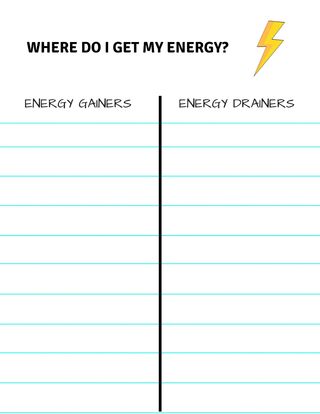Career
Finding Your Energy at Work
Discover what motivates you and get rid of what doesn’t.
Posted May 28, 2019 Reviewed by Jessica Schrader
My last few blog posts have focused on the power of “simple” lists. You can use lists to identify your “perfect” job, determine if you’re still in the right job, or keep track of your work-related competencies to craft a better resume.
Now that you’ve mastered the deceptively simple lists, let’s ratchet up a bit. We’re going to look at what you can do with two-column lists. It’s amazing what just adding another column to your list can do. Two columns increase and enhance your decision-making skills by helping you clarify all the elements in the decision-making process. They allow you to compare and contrast, identify pros and cons, see what is vs. what might be, and so on. Two column lists also allow for change, movement, and growth as you will see. Try these out when you need to weigh options or focus on changes you want to make.
Let’s try a list I have found invaluable for clients who are thinking about changing careers. It’s loosely based on Amy Wrzesniewski’s writings on Job Crafting.
We all do some form of job crafting in our work. We start with the generic job description for the position we’re in, but then we start to add new duties (or pass off other ones) to make the job fit our personal strengths. Job crafting can be one of the most powerful exercises you can do: You might use it to learn that the job you’re in really doesn’t work for you anymore, or you might find that, with just a few tweaks, you can stay in a job that you previously thought you would have to leave. I recommend you look into the writings on Job Crafting (starting with the previously cited article by Justin M. Berg, Jane E. Dutton, Robert L. Kahn, and Amy Wrzesniewski). You might be surprised at how much control you actually have over your day-to-day work activities.
In the meantime though, try this simple two-column list:
Energy Gainers vs. Energy Drainers

Credit for these terms goes to the late Ann McGee-Cooper from her two excellent books You Don’t Have to Go Home from Work Exhausted and Time Management for Unmanageable People, both of which I highly recommend.
This powerful list can be the start of much greater happiness in your current role, or it can give you the information you need to move to a more interesting and fulfilling job. Once you make this list you will be empowered to make changes in your day-to-day experience and maybe even start a new life.
Take out a blank piece of paper and draw a line down the center. On the left side write “Energy Gainers.” On the right side write “Energy Drainers.”
Now, think of all the different activities you do during the week—your duties or responsibilities, the extra work you’ve taken on, the projects you’re involved in, etc. As you consider them, write them under the column that best fits your feelings about them. Do they motivate you? Excite you? Do you gain energy when doing them? Do you enjoy them? If so, they go in the left column. Do you lose energy just thinking about them, dread them, or otherwise wish they weren’t part of your job? Then they belong in the right column.
What have you discovered? Are you columns of equal weight or is one fuller than the other? If the left column is fuller, that’s a great sign. You’re probably in the right line of work. You might want to look at what’s in your right column and see if there’s a way you can give someone else those tasks so you can focus more on your left column activities. Or perhaps set up a reward system for yourself for completing those less-than-desirable tasks.
On the other hand, if you have many more tasks in the right column than the left, you have some decisions to make. How much of your day-to-day work is up to you? Do you have the power or ability to change some of your tasks so you’re not spending so much time with something you don’t enjoy? If not, is it time to look for a job that would offer you more opportunities to do what you enjoy? You can use the left-hand column as the starting point for finding a job that lets you spend more time on those activities.
This can be a great exercise to do with your co-workers, or if you’re a manager, with your staff. Complete the exercise and then share your results with your colleagues. Sometimes you discover that a task you dislike is one that someone else loves. You might be able to switch some duties around with your colleagues so that each of you can do more of what you enjoy. Or if there’s an activity everyone loves or hates, spread it around. Share the experiences, fun or not.
The most important knowledge you will glean from this activity is a new awareness of whether you really are in the right position. If you’ve been thinking about leaving your job, this might just be the exercise that tells you that not only is it time to leave, but it will also give you some guidance on where to go next.
As you can see, a two-column list is a great way to think about your job. If you tried it out, I hope you set goals for making changes in your current role—or confirm the thoughts you had that it might be time to move to another role. We’ll take a look at some more two-column exercises in the next few posts.
©2019 Katharine S. Brooks. All rights reserved.




